

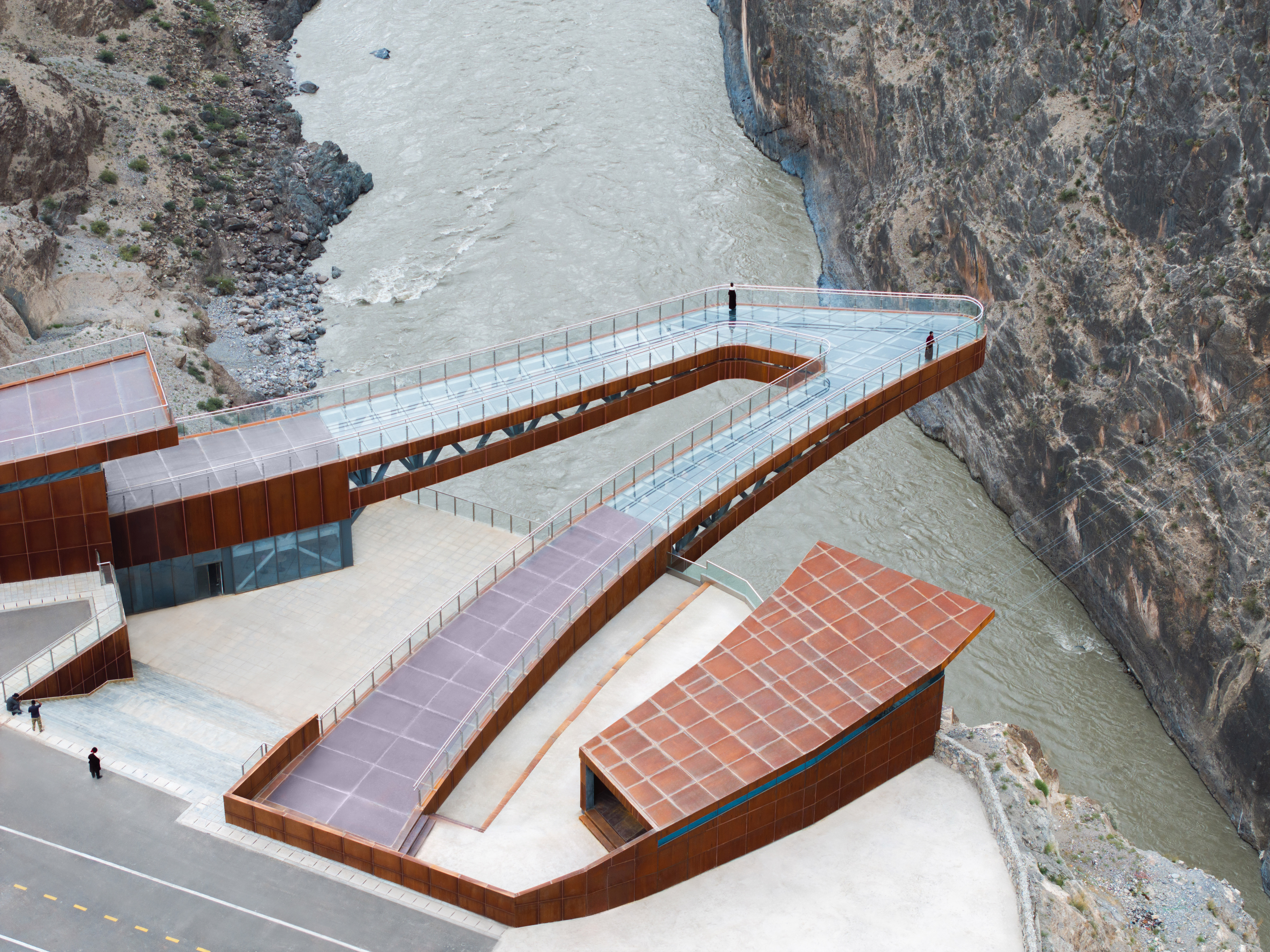
设计单位 小隐建筑事务所(Archermit)
项目地点 西藏昌都市
建成时间 2024年9月
建筑面积 约800平方米
撰文 潘友才、葛祥鑫
▲ 项目视频 ©Chill Shine丘文三映
每个向往西藏的孩子,都有一个G318之梦。川藏线是中国著名的“中国人的景观大道”,一直以来都是游客心中向往的圣地。从成都到拉萨,川藏南线与北线交汇的地方继续往前约200公里,是川藏线上最为壮丽的一段旅程。藏语意为“勇士山脚下的村庄”的这座藏东小城——八宿,邦达草原、怒江大峡谷、然乌湖、来古冰川等著名景点如同粒粒璀璨明珠被G318串联。那些踏上G318追逐梦想的旅行者对“惊险与挑战”最大的期待,就位于川藏线八宿境内的“魔鬼路段”——怒江72拐。
Every child who dreams of Tibet holds a G318 dream. The Sichuan-Tibet Highway, renowned as "China's Scenic Avenue," has always been a sacred route for travelers. About 200 km past the junction of the southern and northern Sichuan-Tibet routes from Chengdu to Lhasa lies the most spectacular part of the journey. In the small town of Baxoi, meaning “village under the warrior’s mountain” in Tibetan, famous sights like the Bangda Grassland, Nujiang Grand Canyon, Ranwu Lake, and Laigu Glacier, all connected like sparkling pearls along G318. For those chasing their dreams on G318, the most anticipated thrill and challenge awaits in the “Devil’s Section” of the Sichuan-Tibet Highway within Baxoi—72 Turns of Nujiang River.
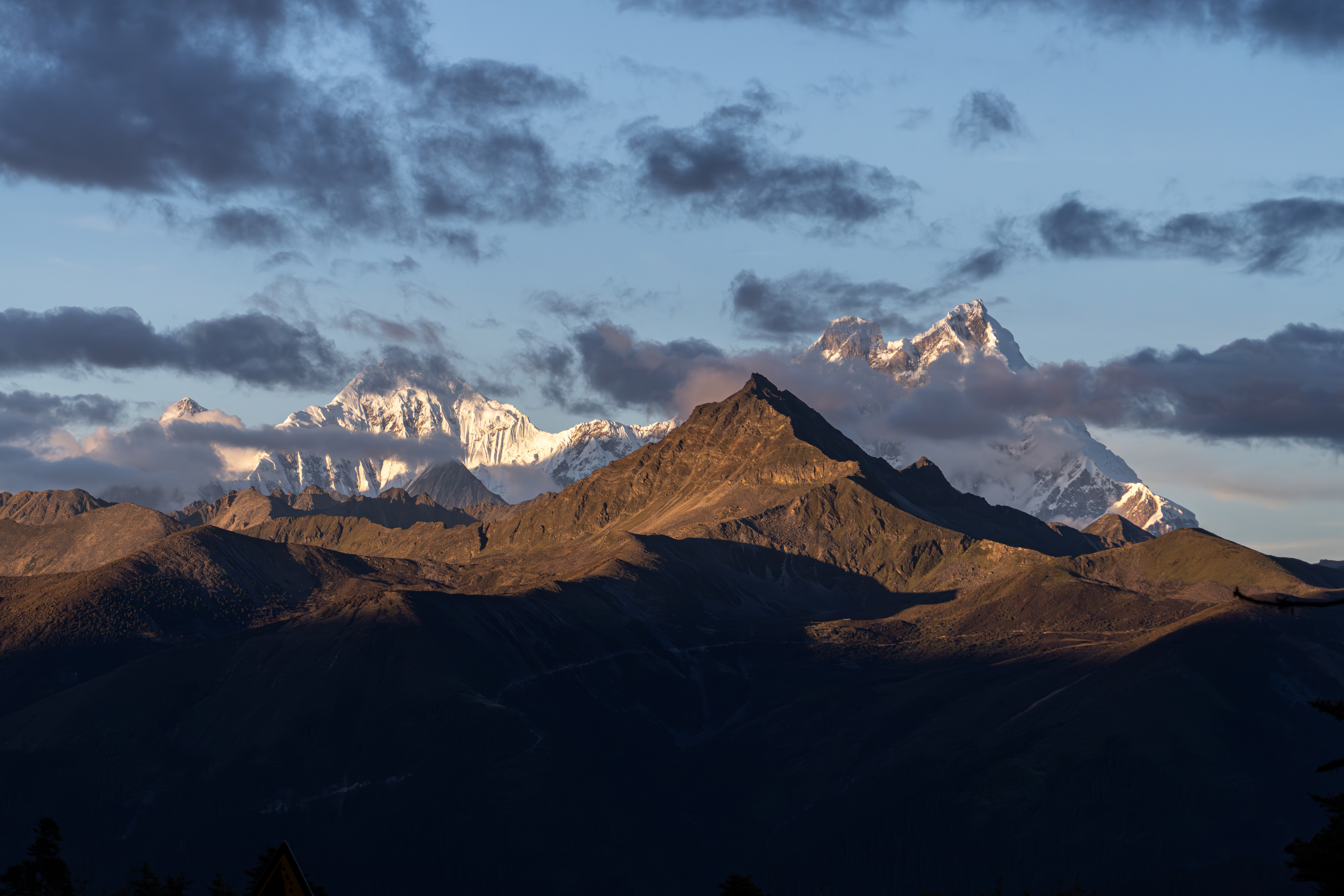





“眼睛在天堂,身体在炼狱”,尽管如此,西藏依然是无数人向往的圣地。无论是文化信仰,还是风景民俗,“体验”必是各类西藏旅行者的目的。无论是磕长头、徒步、骑行还是自驾,挑战自我都是众多“藏迷”的信念与追求。2017年,我们曾用然乌湖国际自驾与房车营地介绍过著名的藏东明珠然乌湖。七年后的今天,我们将与大家分享这段发生在魔鬼公路怒江72拐的旅程。2019年3月,怒江72拐山脚的江边悬崖之上,一个疯狂而大胆的造梦行动开始实施。历经六年的艰难挑战,2024年9月,怒江72拐大峡谷景区落成。它的出现,将为G318的旅行者提供一个追寻刺激与挑战的乐园。
The saying 'eyes in heaven, body in hell' reflects the personal experience of many visitors to Tibet. Despite this, Tibet remains a spiritual destination for countless people. Whether it's the cultural beliefs or the landscapes and local customs, the 'experience' is the key motive for all types of travelers to Tibet. Whether through prostration pilgrimage, trekking, cycling, or self-driving, self-challenge is the core belief and pursuit for many Tibet enthusiasts. In 2017, we introduced the famous eastern gem of Tibet, Ranwu Lake, through the Ranwu Lake International Self-Driving and RV Camping Project. Now, seven years later, we are excited to share the journey through the Devil's Road, the 72 Turns of Nujiang. In March 2019, a bold and daring dream began to take shape on the cliffs by the river at the foot of the 72 Turns. After six years of tough challenges, in September 2024, the Nujiang River 72 Turns Canyon Scenic Area has been completed. Its arrival will offer G318 travelers a new playground to pursue thrills and challenges.


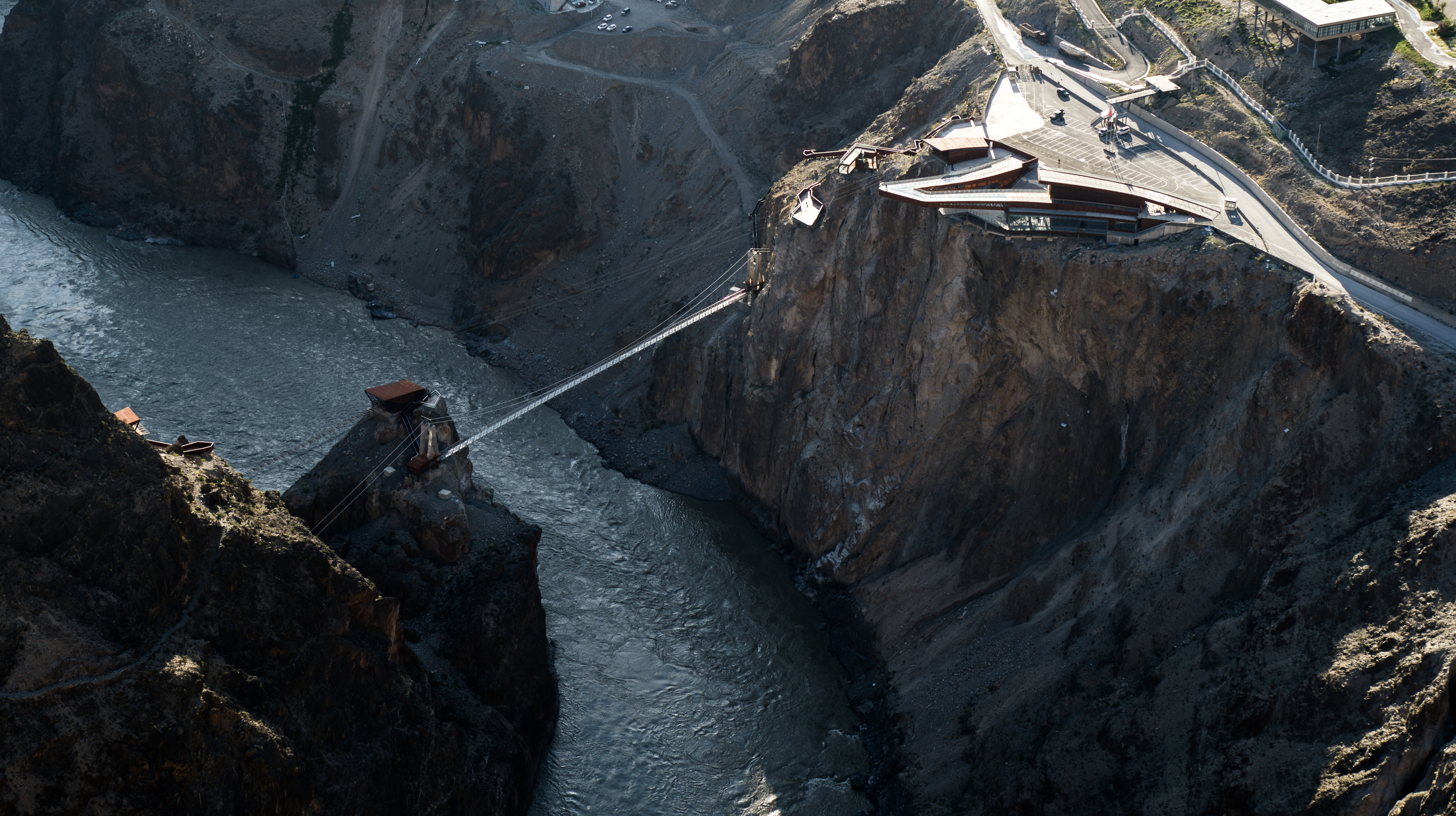


怒江72拐大峡谷景区位于西藏昌都市八宿县布则村,距离八宿县城约48.5公里,距离昌都邦达机场约97公里。景区在G318川藏南线怒江大峡谷中,所在区域是G318最危险路段著名的“天路72拐”和怒江大峡谷。怒江72拐大峡谷景区的设计、建造和未来游客的游玩体验,都展示了极大的挑战精神,是对创造川藏公路伟大奇迹的一次致敬。所有的设计灵感都来自这条魔幻的景观大道。
The Nujiang River 72 Turns Canyon Scenic Area is located in Buze Village, Baxu County, Changdu City, Tibet, approximately 48.5 kilometers from Baxoi County and about 97 kilometers from Bangda Airport in Changdu. The scenic area is situated in the Nujiang Grand Canyon along the G318 Sichuan-Tibet South Line, in the region known for the most dangerous section of the G318, the famous 'Heavenly Road 72 Turns' and the Nujiang Grand Canyon. The design, construction, and future visitor experiences of the Nujiang River 72 Turns Canyon Scenic Area all embody a spirit of great challenge and pay tribute to the monumental achievements of the Sichuan-Tibet Highway. All design inspiration comes from this magical scenic avenue.

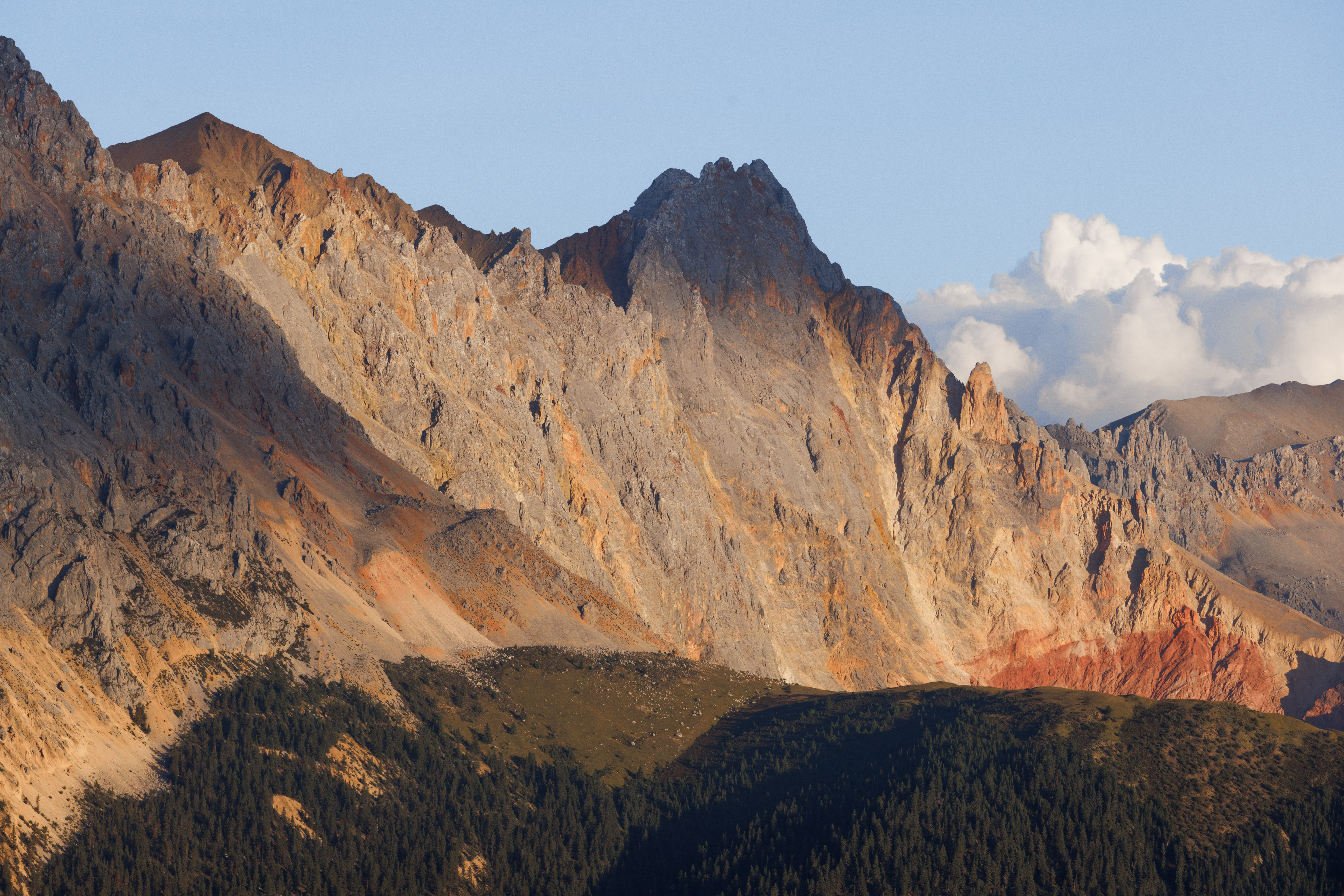


高空玻璃观景台作为项目的核心建筑,以怒江72拐标志性的“发卡弯”道路线型为象源。在怒江峡谷130多米落差的悬崖峭壁之上,钢桁架结构向外单臂悬挑37米形成“发卡弯”。悬于怒江之上的地面铺设高透安全玻璃,在空中形成一条名副其实的“天路”,将怒江72拐惊险的车行体验转化为更为极致的高空步行体验,让游客有机会深度体验怒江峡谷的壮美狂野和荡气回肠。外观材料以藏红色耐候钢板为主材,既是对藏地色彩文化的回应,也能从周边环境中脱颖而出。极具耐候性的钢材不仅坚固耐用,其粗糙的肌理与周边粗犷的山水也能形成对话与融合。
The high-altitude glass viewing platform serves as the core structure of the project, inspired by the iconic 'hairpin turn' road layout of the Nujiang River 72 Turns. Perched on the cliffs of the Nujiang Canyon, with a drop of over 130 meters, the steel truss structure extends outward with a single cantilever of 37 meters, forming the 'hairpin turn.' The ground is laid with high-transparency safety glass, creating a true 'heavenly road' in the air, transforming the thrilling driving experience of the Nujiang River 72 Turns into an ultimate high-altitude walking experience. This allows visitors to deeply experience the majestic wild beauty and breathtaking allure of the Nujiang Canyon. The exterior materials primarily consist of weather-resistant steel plates in a Tibetan red color, responding to the cultural significance of the region’s colors while also standing out from the surrounding environment. The highly weather-resistant steel is not only sturdy and durable, but its rough texture also engages in a dialogue and fusion with the rugged landscapes around it.







横跨怒江的滑索和步步惊心挑战桥,在国内类似的游乐项目中早已不是新鲜事物,但他们出现在这里却极为必要。回看川藏公路的建设过程,可以发现大量类似这类游乐设施的施工场景,正是这些极其危险的施工手段,成就了川藏公路的奇迹。在70年前修路建桥技术还不成熟的年代,建设者的智慧与勇气不得不让人叹服。虽然如今我们拥有了非常先进的建造技术和手段,但是受到怒江峡谷地理及交通的限制,怒江72拐大峡谷景区的建造依然只能采用几十年前的很多“土办法”才得以呈现。通过滑索和步步惊心挑战桥的体验,我们能够更深刻的感受川藏公路建造的不易,这正是它们存在的意义和价值。
The zip line and Thrilling Steps challenge bridge that span the Nujiang River are not new concepts in similar amusement projects across the country, but their presence here is necessary. Looking back at the construction process of the Sichuan-Tibet Highway, one can find numerous scenes of similar amusement facilities under construction; it is precisely these extremely dangerous construction methods that have contributed to the miracle of the Sichuan-Tibet Highway. Seventy years ago, when road and bridge construction technology was still immature, the wisdom and courage of the builders were truly admirable. Although we now possess very advanced construction technologies and methods, the geographical and transportation constraints of the Nujiang Canyon mean that the construction of the Nujiang River 72 Turns Canyon Scenic Area still relies on many 'traditional methods' from decades ago. Through the experiences of the zip line and the Thrilling Steps challenge bridge, we can gain a deeper appreciation of the difficulties faced in building the Sichuan-Tibet Highway, which is the true significance and value of their existence.

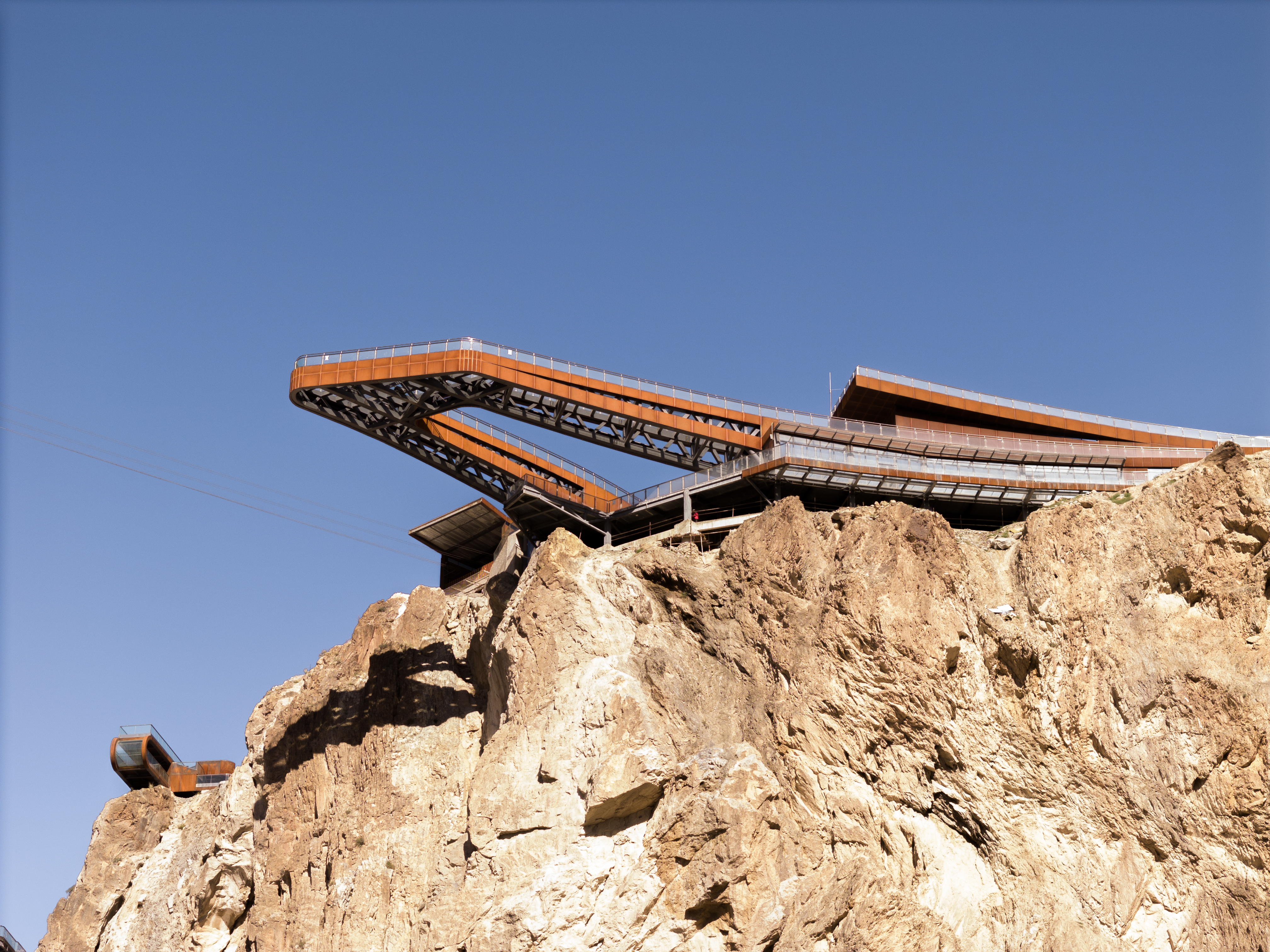
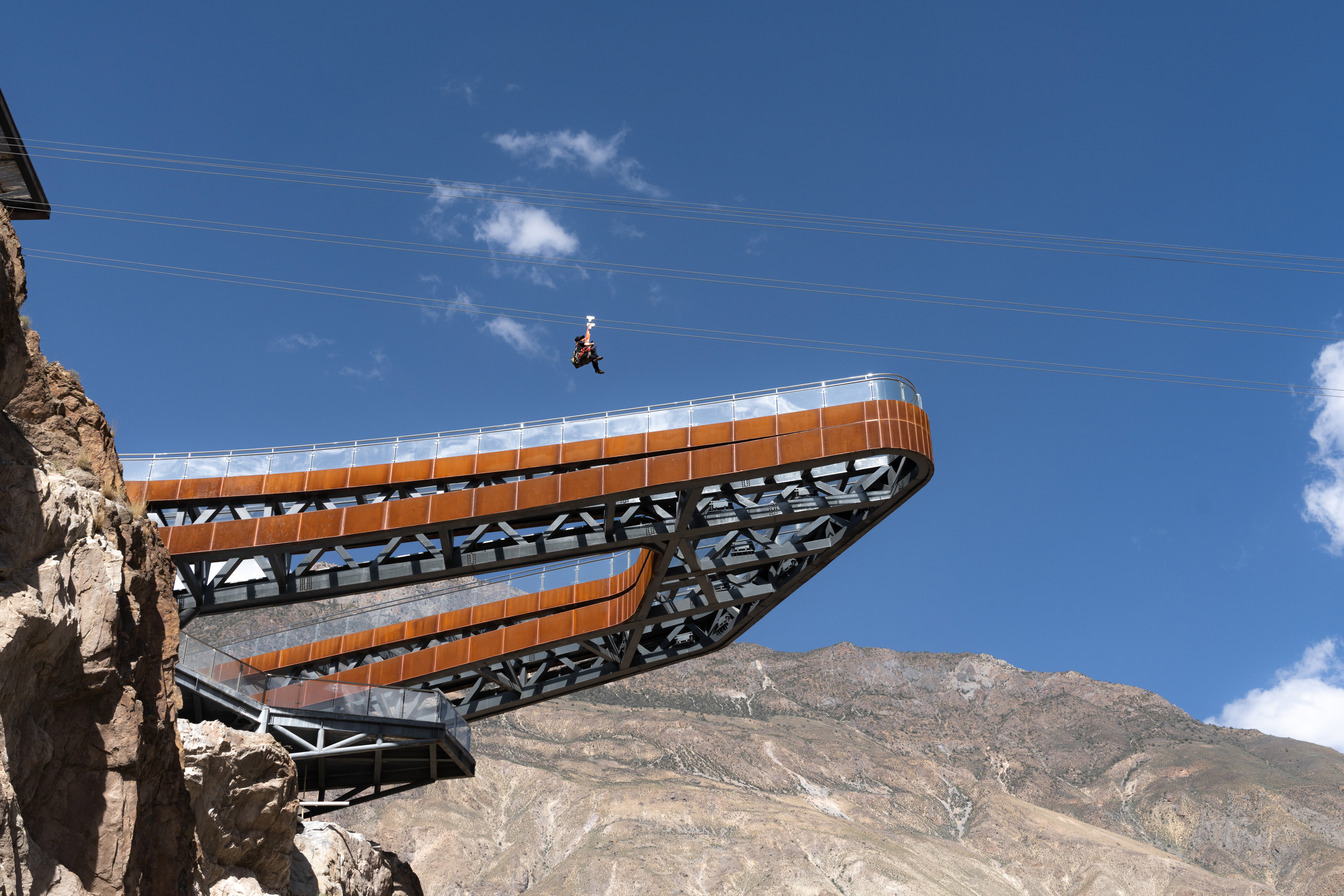
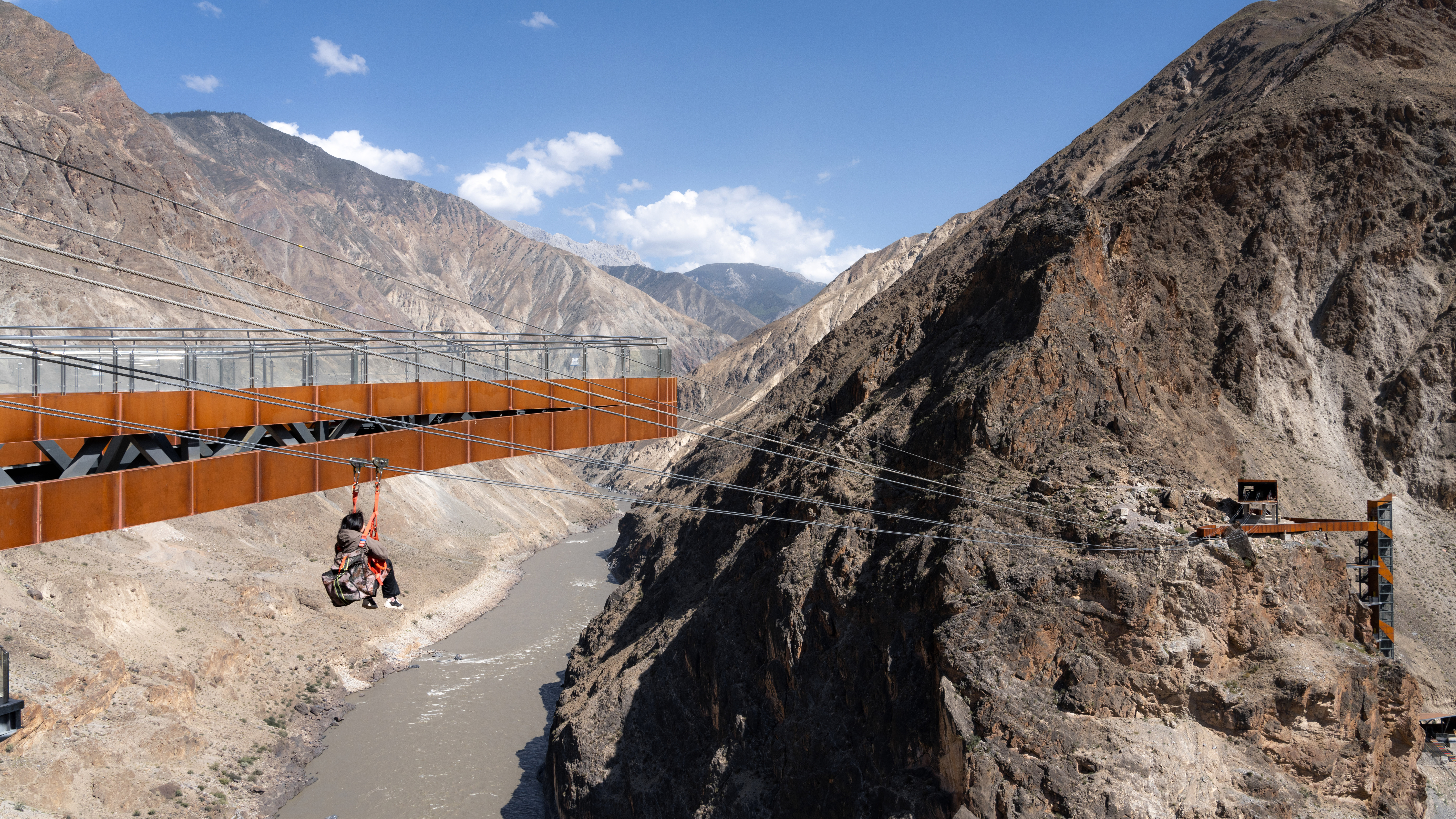



景区往八宿方向,距离不到两公里便是著名的怒江大桥。最初的怒江大桥是一座钢架桥,桥面铺设足以承载车辆通行的钢板。这里重兵把守,过往车辆需要停车检查,排队单车依次通行,车辆通过大桥晃晃悠悠的感受可谓胆战心惊。如今新的怒江大桥建成,老的怒江大桥已成为被人敬仰的历史,但那些鲜活的故事和场景依然在广为传颂,并被人铭记。跨江高空玻璃吊桥的设计正是源于那座晃晃悠悠的钢架怒江大桥。
Heading towards Baxoi from the scenic area, less than two kilometers away lies the famous Nujiang Bridge. The original Nujiang Bridge was a steel structure with a deck made of steel plates sturdy enough to support vehicle passage. Heavily guarded at the time, vehicles had to stop for inspection and queue up for single-file crossing. The experience of driving across the shaky bridge was nerve-wracking. Today, a new Nujiang Bridge has been completed, while the old Nujiang Bridge has become a revered piece of history, with its vivid stories and scenes still widely recounted and remembered. The design of the glass suspension bridge that spans the river was inspired by that shaky steel Nujiang Bridge.

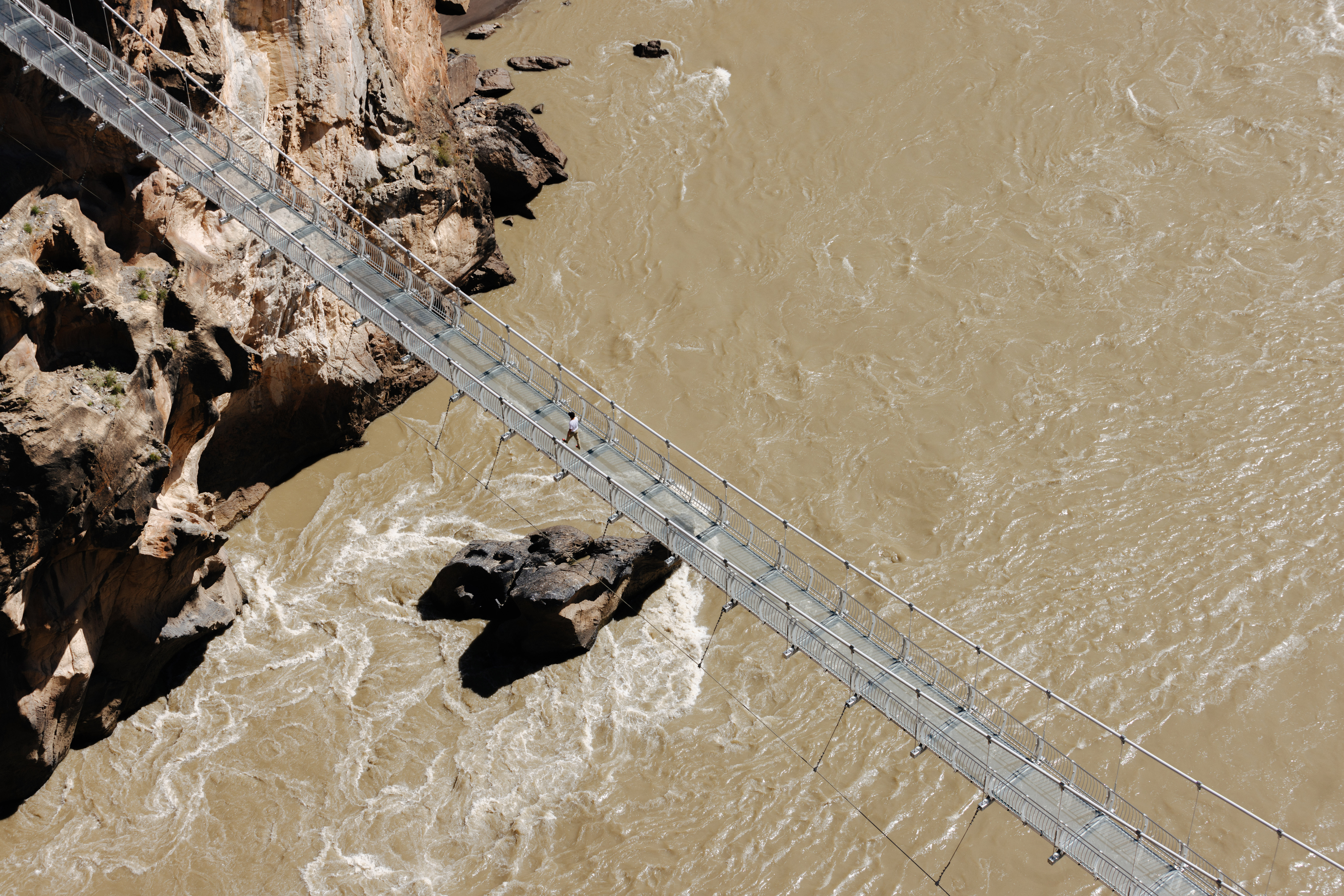

玻璃吊桥采用钢索桥的形式,其自身就自带摇晃的特质,怒江的狂风进一步加剧了晃晃悠悠的不稳定感,高透玻璃桥面更是让游客肾上腺素飙升。同时,玻璃吊桥也是连接怒江两岸的重要纽带,将为景区未来开展徒步、野外探险等活动的拓展提供极大的交通便利。游走在距离怒江50米落差的玻璃吊桥上,怒江的风、怒江的水、怒江的嘶吼、怒江掀起的巨浪……都近在眼前,它们将久久回荡在游客的心中,并在久远的记忆里不时荡起朵朵涟漪。
The glass suspension bridge adopts the form of a cable bridge, which naturally brings a swaying sensation. The fierce winds of the Nujiang River further intensify the instability, and the high-transparency glass deck adds to the adrenaline rush for visitors. At the same time, the glass suspension bridge serves as an important link between both sides of the Nujiang River, greatly facilitating future activities such as hiking and outdoor adventures in the scenic area. As visitors walk along the glass bridge, suspended 50 meters above the Nujiang River, they feel the wind, hear the rushing water, the roaring river, and witness the crashing waves—all so close. These sensations will linger long in the minds of the visitors, creating ripples in their memories for years to come.


怒江南岸的观光电梯,是因山地陡峭游客无法行走而设计的。从便利性的设计角度看,其实两岸都适合设置观光电梯。就北岸来说,游客体验完玻璃吊桥,坐上电梯,轻松愉快地到达一叶观景台,爬一小段坡到达太空舱观景台,再爬一小段坡便结束,整个游玩过程是更轻松、更舒适的。
The sightseeing elevator on the southern bank of the Nujiang River was designed because the steep terrain makes it difficult for tourists to walk. From a convenience standpoint, elevators could have been installed on both banks. On the north bank, for example, after crossing the glass suspension bridge, visitors could take an elevator to easily reach the Leaf Viewing Platform, ascend a short slope to the Space Capsule Viewing Platform, and then climb another short slope to finish, making the entire experience much more relaxed and comfortable.


但我们还是决定抛弃这种舒适性,未在北岸设置电梯,取而代之的是“天怒666梯”,当游客喘着粗气爬完这段路程,回头再看走过的路,才能真正明白当年川藏公路建设者以及怒江72拐大峡谷景区的建造所经历的艰辛,才能体会怒江72拐大峡谷景区“用身体丈量怒江天险”的意义。
However, we chose to forgo this comfort and did not install an elevator on the north bank. Instead, we built the "Sky Fury 666 Ladder." When visitors, breathless and letting out a string of curses, finally complete this challenging climb and look back at the road they’ve traveled, they will come to truly understand the hardships faced by the builders of the Sichuan-Tibet Highway and the Nujiang River 72 Turns Canyon Scenic Area. Only then can they fully appreciate the meaning of “measuring the treacherous Nujiang with one’s own body.”



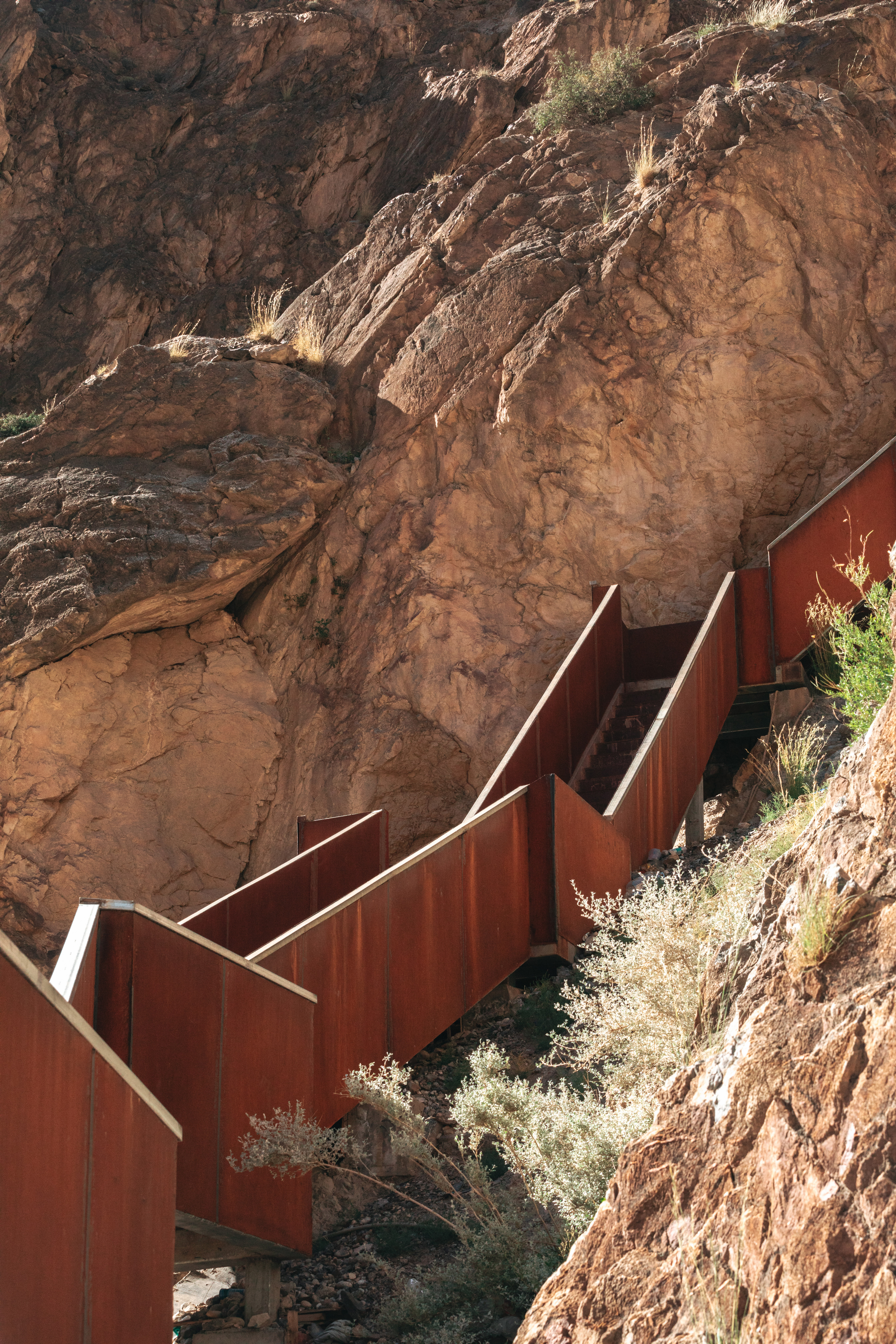

游客最后一段的体验虽然艰难,但毕竟只是赤手空拳的状态下短暂而自主的身体疲累,而这些工程的实现必是勇者所为,他们甚至为此付出了生命的代价。人生路上,有多少成功能唾手可得,在最接近成功的时刻,往往都是最艰难的。这一段路,除了感叹,也许能让游客体悟。
While the final stretch of the journey is difficult, it is still just a brief, voluntary physical exhaustion, unburdened by heavy loads. But achieving these monumental engineering feats was the work of brave souls, some of whom even gave their lives. How many successes in life are easily attained? Often, the moment closest to success is the hardest. This final stretch, beyond inspiring awe, may also allow visitors to gain an embodied understanding through their physical experience.





怒江72拐大峡谷景区的设计力求将怒江天险的体验推向极致,“险中求险,挑战自我”,打造西藏新的地理标志。让G318的旅行者挣脱车辆的束缚,用身体丈量怒江天险。这里将为游客提供一处挑战自我身体、心理、思维的“道场”,成就一次以自己身体为刻度的难忘旅行体验。
The design of the Nujiang River 72 Turns Canyon Scenic Area aims to elevate the experience of confronting the peril of the Nujiang River to the extreme, embodying the concept of “seeking danger within danger and challenging oneself,” thus creating a new geographical landmark for Tibet. It allows travelers on the G318 to break free from the confines of their vehicles and measure the peril of the Nujiang River with their own bodies. This area will provide visitors with a space to challenge their physical, psychological, and mental limits, crafting an unforgettable travel experience that is measured by their own endurance

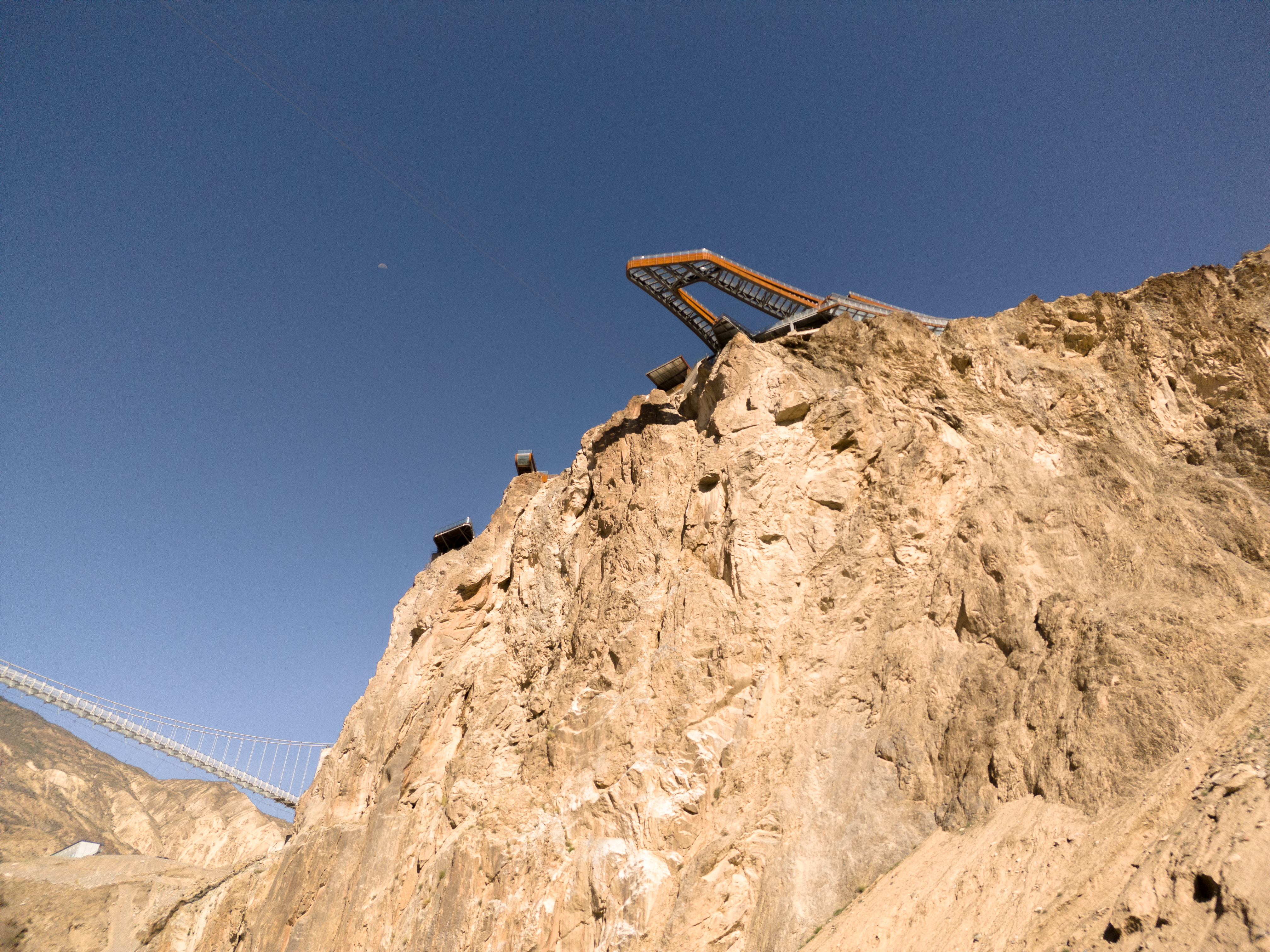



长在悬崖之上的梦想——历时六年的高海拔工程实践挑战
西藏大部分地区一年有超过5个月的冰雪天气,夏季突发的雨雪、高温、大风等恶劣天气使得一年当中可以正常施工的时间和周期非常有限。另外,西藏地形复杂,大部分地区道路崎岖、弯多弯急、隧道涵洞密布,这些问题在怒江72拐和怒江大峡谷“老虎嘴”等路段尤为突出。泥石流塌方等造成道路损毁的情况也时有发生,这对施工材料和施工设备运输带来非常大的影响。超过13米的建材几乎无法运达施工现场,大型施工设备如吊车、打桩机等无法运送,道路损毁和恶劣天气也会导致运输时间的不可控。高海拔对施工人员身体体能更是一项非常大的挑战,怒江观景台海拔2800米左右,仅做桩基础打孔工作就换了6波工人。很多低海拔地区的施工人员根本无法适应高海拔气候,这也导致施工人员的选择变得局限。
Tibet experiences over five months of snow and ice weather each year in most areas. The sudden rain, snow, high temperatures, and strong winds in summer create a very limited time frame and cycle for normal construction activities throughout the year. Additionally, Tibet's complex terrain features rugged roads with many sharp turns and a high density of tunnels and culverts, making these challenges particularly prominent in sections like the Nujiang 72 Turns and the “Tiger Mouth” in the Nujiang Grand Canyon. Instances of landslides and mudflows causing road damage also occur frequently, significantly impacting the transportation of construction materials and equipment. Materials longer than 13 meters are nearly impossible to deliver to the construction site, and large construction equipment such as cranes and pile drivers cannot be transported. Road damage and harsh weather also contribute to uncontrollable transportation times.




高海拔也对一些施工工艺带来非常大的挑战,如电焊、混凝土浇筑、金属板材的安装等。西藏昼夜温差极大,建筑选材也需要非常慎重。应避免采用变形系数大的板材,这些材料容易受温差变化导致老化、变形、脱落的加剧,石材、木材、水泥制品、当地本土材料和一些变形系数小的金属材料比较适用。另外,要尽可能多地采用胶粘的施工工艺,少采用水泥粘接的施工工艺。一方面高寒地区施工周期短不利于水泥粘接施工,极大的温差和冬季冰冻也会造成水泥粘接大量的开裂、剥落、脱落、碱蚀等。
The high altitude presents a significant physical challenge for construction workers; for example, the Nujiang Viewing Platform is located at an altitude of around 2,800 meters, leading to six different waves of workers just for the pile foundation drilling work. Many workers from lower altitude areas simply cannot adapt to the high-altitude climate, which further limits the pool of available labor. High altitude also poses significant challenges for certain construction processes, such as electric welding, concrete pouring, and metal sheet installation. The temperature difference between day and night in Tibet is extreme, so careful selection of building materials is essential. It’s important to avoid using materials with a high deformation coefficient, as these can age, deform, or detach more easily due to temperature fluctuations. Suitable materials include stone, wood, cement products, locally sourced materials, and some metals with low deformation coefficients. Additionally, it is advisable to use adhesive construction techniques as much as possible and minimize the use of cement bonding methods. On one hand, the short construction cycle in cold regions is not conducive to cement bonding work, while significant temperature differences and winter freezing can lead to cracking, spalling, detachment, and alkali corrosion in cement joints.

怒江72拐大峡谷景区在建造过程中遇到的一系列施工难题,在西藏地区的建筑工程中是极具代表性的,几乎囊括了藏区所有建筑工程遇到的问题。项目设计之初,我们就提出了“挑战”的理念,除了为游客提供独特的“挑战”体验之外,项目本身的设计和建造也是一次高海拔地区工程建设的重大“挑战”,对我们在藏地工程的建筑实践有着非常重要的意义。
The construction process of the Nujiang River 72 Turns Canyon Scenic Area faced a series of challenges that are highly representative of construction projects in Tibet, encompassing nearly all the issues encountered in the region’s architectural endeavors. From the very beginning of the project design, we established the concept of “challenge.” Beyond providing visitors with a unique “challenging” experience, the design and construction of the project itself represent a significant “challenge” in high-altitude engineering. This has great significance for our architectural practices in Tibet.

怒江72拐大峡谷景区北岸紧临G318,道路设施非常完善,但南岸却仅有可供人徒手攀爬步行的毛路,可达性非常差。同时,项目海拔较高,空气含氧量低,且正好处于河谷风口,常年伴随六级以上大风。两岸山体表层地质结构不够稳定,雨季期间落石现象时有发生,施工安全隐患极大。项目从一开始的地形测绘、地质勘查开始,设计工作就困难重重。
The north bank of the Nujiang River 72 Turns Canyon Scenic Area is adjacent to the G318 highway, with well-developed road facilities, while the south bank only has rough paths for hand-climbing, making accessibility very poor. Additionally, the project is situated at a high altitude with low oxygen levels and is located right in the valley wind corridor, often experiencing winds of level six or higher. The geological structure of the mountain slopes on both banks is unstable, and rockfalls are common during the rainy season, posing significant safety hazards for construction.


为了营造天路72拐和怒江大峡谷“险中求险”的极致体验,设计方案也做了非常大胆的尝试。我们后续为之做了大量的专项设计论证工作,地灾评估、风洞试验、TMD计算、悬臂钢结构施工模拟等,为后期的施工建造提供了足够的技术支撑。项目建设过程中,我们联合多家权威机构、多位业界专家、教授与施工团队一起攻克了重重难关,历时六年,终于让项目得以完美的落地呈现。以下例举几个让我印象深刻的事情,以对工友们的智慧与勇气聊表敬意。
From the very beginning, starting with terrain mapping and geological surveys, the design work faced numerous challenges. To create the ultimate “extreme challenge” experience of the Sky Road 72 Turns and the Nujiang Grand Canyon, the design plans involved very bold attempts. Subsequently, extensive specialized design verification was conducted, including disaster assessments, wind tunnel tests, TMD calculations, and cantilever steel structure construction simulations, all providing sufficient technical support for the later construction phase. During the project’s construction, we collaborated with multiple authoritative institutions, industry experts, and professors, along with our construction team, to overcome numerous obstacles. After six years of hard work, the project was successfully brought to fruition. Here, I would like to highlight a few impressive moments that pay tribute to the wisdom and courage of our workers!

景区建筑物和构筑物分部在横跨260多米的怒江两岸,南岸崎岖的毛路需手脚并用才能通行。前期虽然做了详细的地形测绘,但在实际测量放线时还是困难重重。有些点位处于悬崖峭壁上,河谷的风非常大,无人机无法精准操控,只能选择RTK测量仪人工放线。因为没有施工便道,工人绑上安全绳悬吊在悬崖上测量放线的身影,让人触目惊心、忧心忡忡。但这还只是故事的开始,仅仅是个小小的序曲。
The scenic area’s buildings and structures are distributed across both banks of the Nujiang River, which spans over 260 meters. The south bank features rugged paths that require both hands and feet to navigate. Although detailed terrain mapping was conducted in advance, the actual measurement and alignment faced numerous difficulties. Some points were located on steep cliffs, and the strong winds in the valley made it impossible to control drones accurately; thus, we had to rely on RTK surveying equipment for manual alignment. Due to the lack of construction access roads, workers had to secure themselves with safety ropes and dangle over the cliffs to carry out measurements and alignment, a sight that was both alarming and concerning. But this was just the beginning of the story, merely a small overture.

天路72拐和怒江大峡谷“老虎嘴”之间这个特殊的地理位置,导致大型机械无法运抵现场。高空玻璃观景台桩基础施工时,39个桩基分布在悬崖峭壁的不同地质面层,由于没有道路和平整的施工作业面,只能选择人工水磨钻方式进行桩基施工。地基下部全部为岩石,岩层不断变化,多数岩层极其坚硬,我们更换了国内市面上50多种钻头都无法达到钻孔深度。项目部送取岩石样品至重庆、山东等刀具厂家进行岩石分析,为项目量身定制钻头问题才得以解决。
The unique geographical location between the Sky Road 72 Turns and the “Tiger Mouth” of the Nujiang Grand Canyon made it impossible to transport large machinery to the site. During the construction of the pile foundations for the high-altitude glass viewing platform, 39 piles were distributed across different geological layers on the steep cliffs. Due to the lack of roads and a level working surface, we had to resort to manual water-cooled drilling methods for the pile foundation work. The substrate was entirely rocky, with constantly changing rock layers, and most of these layers were extremely hard. We tried over 50 different types of drill bits available in the domestic market, but none were able to reach the required drilling depth. The project team sent rock samples to tool manufacturers in Chongqing, Shandong, and elsewhere for analysis, which eventually led to the development of customized drill bits for the project.


39个桩基最深的达25米,由于桩基很深,钻孔后期只能采用0.6米深分层钻取的方式,用直径110毫米的水磨钻将周围一圈钻空取出,然后工人吊着安全绳下到直径1.8米的孔底,将中间剩余的岩石人工破碎,通过吊篮吊出。钻一层取一层,如此0.6米往下层层递进。39个桩基在更换6个施工班组的情况下,经过数百人的努力,历经半年之后才得以完成。
The deepest of the 39 piles reached 25 meters. Because of the depth, the later stages of drilling could only be conducted using a layered approach, drilling down 0.6 meters at a time. Workers used a 110 mm diameter water-cooled drill to create a circle of holes around the perimeter and then, secured by safety ropes, descended to the bottom of the 1.8-meter diameter hole to manually break up the remaining rock in the center, which was then hoisted out using a basket. This process involved drilling and extracting layer by layer, progressing downwards in increments of 0.6 meters. After changing six construction teams and with the effort of hundreds of workers over six months, the 39 pile foundations were finally completed.


施工人员和材料在施工现场的转运也是一个难题。项目施工初期,由于怒江南岸没有施工便道,施工人员需要驾车绕行几公里,从临时便桥跨过怒江,再步行至施工点位,在海拔2800多米的条件下,工人从施工板房到达施工点位需要接近2个小时,来回耗费约4个小时(无负重的情况下)。南岸的各类建筑基础也是钢筋混凝土深桩基,主体采用钢结构、混凝土、钢构件、耐候钢板、不锈钢、特种玻璃等。用于怒江南岸的材料虽然经过多次的设计拆解,但仍然非常笨重,单靠人力依然无法运送。一些中小型的施工机械(挖掘机、破碎机、空压机等等)也无法到达南岸。为此,项目部采用几十年前修建川藏公路的跨江方式,搭建了临时跨江滑索,保障施工机械和施工人员在两岸的往来。后来又架设了货运滑索,保障施工材料顺利送达南岸。同时,多方协调努力,将一台100吨吊车从72拐方向送达北岸施工现场,并在北岸搭建了60式塔吊。施工材料运达现场后使用吊车卸货,通过塔吊转运至过江吊装平台,再通过滑索送达对岸,之后只得采用人工方式转运至各施工部位,前后需要至少四次转运。
The transportation of construction personnel and materials to the site was also a significant challenge. In the early stages of the project, due to the lack of access roads on the southern bank of the Nujiang River, construction workers had to drive several kilometers around to cross the river via a temporary bridge and then walk to the construction site. At an altitude of over 2,800 meters, it took workers nearly two hours to reach the site from the construction barracks, consuming about four hours for a round trip (without carrying any loads). The various building foundations on the south bank consisted of reinforced concrete deep piles, while the main structure utilized steel, concrete, steel components, weather-resistant steel plates, stainless steel, and special glass. Although the materials designated for the southern bank had undergone multiple design breakdowns, they were still quite heavy and could not be transported solely by manpower. Additionally, some small to medium-sized construction machinery (such as excavators, crushers, and air compressors) could not reach the south bank. To address these challenges, the project team implemented a temporary cableway similar to the one used decades ago during the construction of the Sichuan-Tibet Highway, allowing for the transportation of construction machinery and personnel between the two banks. Subsequently, a freight cableway was established to ensure that construction materials could be delivered smoothly to the southern bank. Through extensive coordination, a 100-ton crane was transported from the 72 Turns direction to the construction site on the northern bank, where a 60-ton tower crane was also erected. Once the construction materials arrived at the site, they were unloaded using the crane and transferred via the tower crane to a river-crossing hoisting platform. From there, the materials were sent across the river using the cableway, and subsequently, they had to be manually transported to various construction locations, requiring at least four transfer operations in total.




由于地域交通的限制,浇筑混凝土这件稀松平常之事在怒江也变得异常艰难。距离项目地最近的混凝土搅拌站在八宿县城,相隔40多公里,车程约1个小时。由于项目地形和道路原因,搅拌车无法到达怒江南岸,搅拌车载重太重,也无法通过货运滑索过江。为此我们在怒江上搭建了一座约150米长的钢索便桥,在便桥上铺设混凝土输送专用管道,将混凝土打到对岸。
Due to the limitations of regional transportation, the seemingly simple task of pouring concrete became exceptionally challenging in the Nujiang area. The nearest concrete mixing station is located in Baxoi County, over 40 kilometers away, with a travel time of about one hour. However, due to the terrain and road conditions, the mixer trucks could not reach the southern bank of the Nujiang River, and their heavy loads also prevented them from using the freight cableway to cross the river. To address this issue, a steel cable bridge approximately 150 meters long was constructed over the Nujiang River, along with a dedicated concrete delivery pipeline laid on the bridge to transport the concrete to the opposite bank.


由于管道过长,混凝土输送过程经常发生堵管的情况。一旦堵管则必须在一小时内立即疏通,否则混凝土凝固,就得重新铺设新的输送管道。另外由于搅拌站距离太远,搅拌车运输过程耗费时间久,跨江的输送也非常复杂,所以每一车混凝土都需要争分夺秒,合理安排好整个运输和浇筑流程,稍有不慎延误时间,一车混凝土就报废了。怒江南岸混凝土浇筑点位较多,部分悬崖顶部的栈道点位因输送距离太长,不能采用混凝土输送管直接浇筑,只能选择自拌料方式工作,为了达到质量要求,施工效率极低、进度极其缓慢。
However, the length of the pipeline often led to blockages during the concrete delivery process. If a blockage occurred, it had to be cleared within an hour; otherwise, the concrete would solidify, necessitating the installation of a new delivery pipeline. Moreover, the significant distance from the mixing station resulted in long transportation times for the mixer trucks, making the cross-river delivery quite complex. Therefore, each batch of concrete had to be delivered and poured with utmost urgency, requiring careful scheduling of the entire transportation and pouring process. Any delay, even minor, could result in a batch of concrete being wasted. The southern bank had multiple concrete pouring locations, and some points on the tops of cliffs had delivery distances that were too long for direct pouring using the concrete delivery pipes. In such cases, workers had to resort to self-mixing concrete, which significantly lowered the construction efficiency and caused the progress to be extremely slow in order to meet quality requirements.


在西藏这种交通运输不便、施工受天气影响非常大的地方,钢结构是非常理想的建造方式,现场施工量少、安装快捷、综合造价可控。高空玻璃观景台为钢桁架结构,悬臂端最远处悬挑37米,最近处悬挑27米,悬臂支座附近桁高2.4米,桁架高度由支座处向悬臂端逐渐减小,悬臂端部桁高1.5米,离怒江垂直高度130多米。由于G318的运输限制,采用钢结构建造时,要特别注意结构构件的合理拆分,保证材料力学性能的前提下,将材料拆分为便于运输的尺寸规格。整个钢结构桁架在工厂分46段制作运输至现场,在现场拼装后再进行吊装,其中悬挑部分主桁架分为26段。钢结构便于分解组合的特点,确保了观景台结构材料顺利的运输和安装落地。
In Tibet, where transportation is inconvenient and construction is greatly affected by weather conditions, steel structures are an ideal building method due to their minimal on-site construction volume, quick installation, and controllable overall costs. The high-altitude glass viewing platform features a steel truss structure, with the furthest cantilever extending 37 meters and the nearest one extending 27 meters. The truss height near the cantilever support is 2.4 meters, gradually decreasing to 1.5 meters at the cantilever end, which is more than 130 meters above the Nu River. Due to transportation restrictions on the G318, particular attention must be paid to the rational division of structural components when constructing with steel, ensuring that materials are split into transportable sizes while maintaining their mechanical performance. The entire steel truss was fabricated in 46 sections at the factory and then transported to the site for assembly and hoisting, with the main truss of the cantilever portion divided into 26 sections. The modular nature of steel structures facilitated the smooth transportation and installation of the viewing platform's structural materials.


由于吊装对悬臂结构的预起拱、焊接、控制点位移等要求极高,加上现场随时伴有大风,整个安装过程对工人要求之高,在西藏地区也是罕见的。外观主材采用红色耐候钢板和进口SGP夹胶玻璃。这些主材共同特性是耐候性好,施工工艺相对简单,便于简化现场操作,利于项目落地。项目其他的组成部分也都采用钢结构、耐候钢板、玻璃这几种材料作为主材,在怒江大峡谷共同描绘了一抹别样的红色。
The hoisting process requires extremely high precision in terms of pre-cambering the cantilever structure, welding, and controlling point displacement, compounded by the frequent strong winds on-site; this high requirement for labor skills is rare even in the Tibet region. The main exterior materials are made of red weathering steel plates and imported SGP laminated glass. These materials share the characteristics of excellent weather resistance, relatively simple construction processes, and ease of simplifying on-site operations, which is beneficial for project implementation. Other components of the project also utilize steel structures, weathering steel plates, and glass as primary materials, collectively creating a unique splash of red in the Nujiang Grand Canyon.





西藏很多地区都依靠旅游产业的带动发展,如果没有人们的参与,也就没有了经济流通,很多地方就愈发荒芜贫瘠。项目建设初期,为了给景区做相关的旅游配套,我们在景区山坡北侧规划种植了近500亩果林,六年时间转瞬而过,这片原本是荒漠的土地已经被绿荫覆盖。果林也已投产两年,藏区充足的日照条件让这片土地上长出的葡萄、梨、桃子、苹果都无比的香甜可口。怒江72拐大峡谷景区目前已为当地提供了至少48个就业岗位,就业收入超过300万元每年。未来,我们衷心地希望这个项目能为区域旅游赋能,吸引更多游客的到来,为这片热土的发展注入新的活力。让这一片荒漠悬崖之上,也能长出无数的希望,为西藏地区的旅游产业和经济发展、人口就业、文化传播、农特产品输出等做出重要的贡献。
Many areas in Tibet rely on the tourism industry for development; without people's participation, economic circulation would cease, leaving many places increasingly desolate and barren. In the early stages of the project, to support the tourism facilities in the scenic area, nearly 500 acres of fruit orchards were planned on the northern slope of the scenic area. Six years have passed in the blink of an eye, and this land, once a desert, is now covered in greenery. The fruit orchards have been in production for two years, and the ample sunlight in the region has resulted in exceptionally sweet and delicious grapes, pears, peaches, and apples. The Nujiang 72 Bends Grand Canyon scenic area has currently provided at least 48 jobs for locals, with an annual employment income exceeding 3 million yuan. In the future, we sincerely hope this project can empower regional tourism, attract more visitors, and inject new vitality into the development of this vibrant land. May this once-desolate cliffside bloom with countless hopes and make significant contributions to the tourism industry, economic development, job creation, cultural dissemination, and the export of local agricultural products in Tibet.

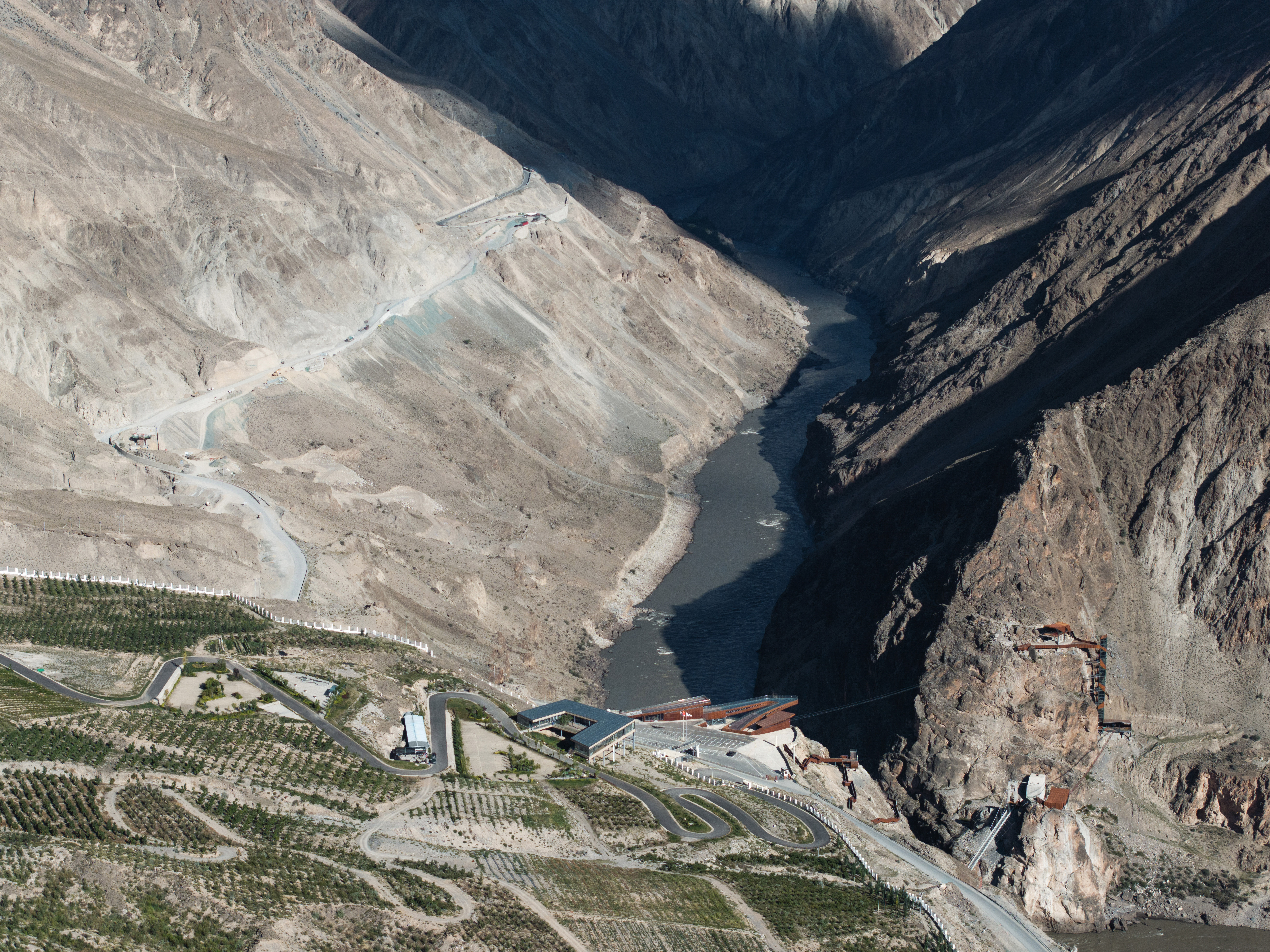
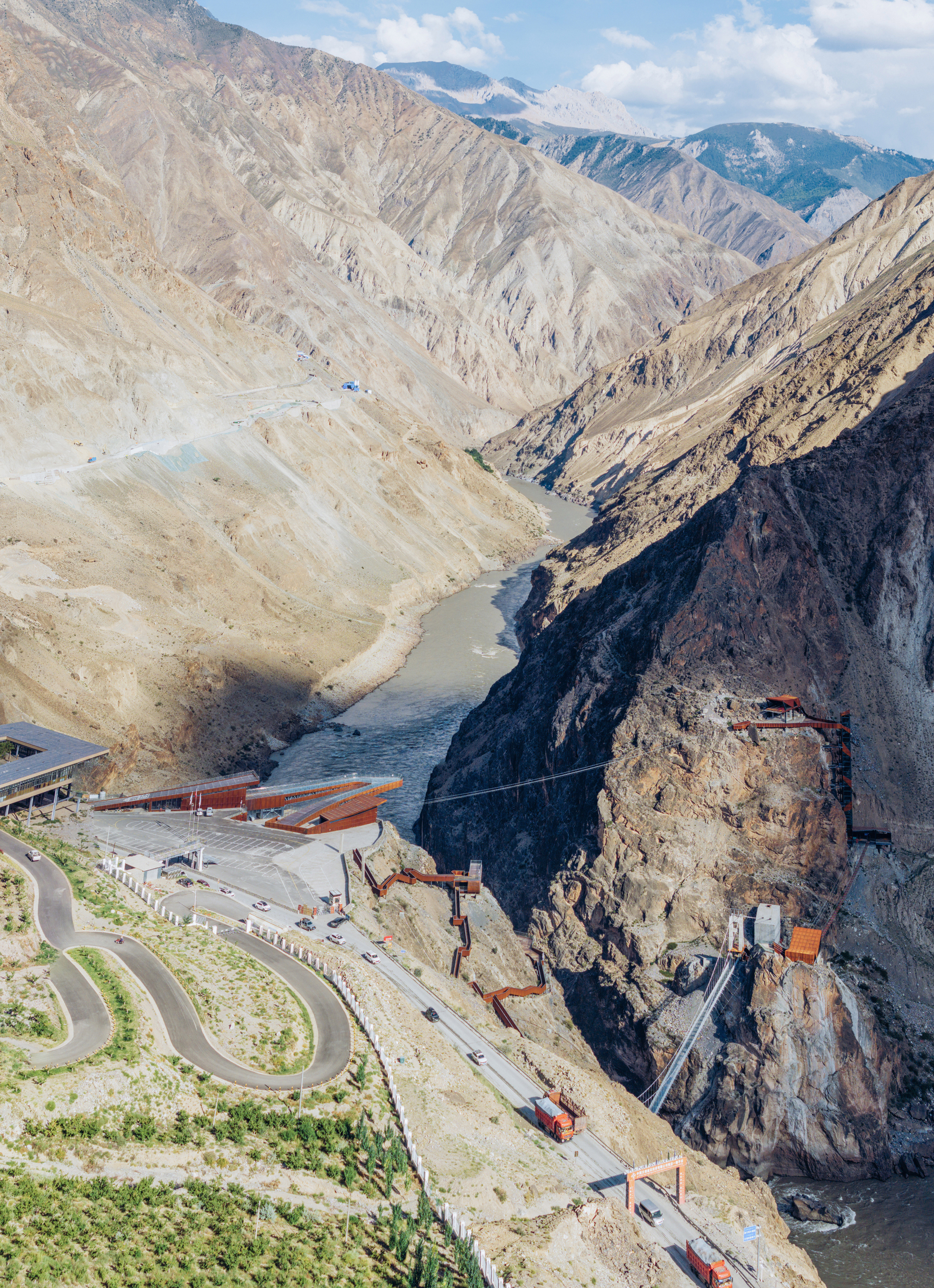
设计图纸 ▽



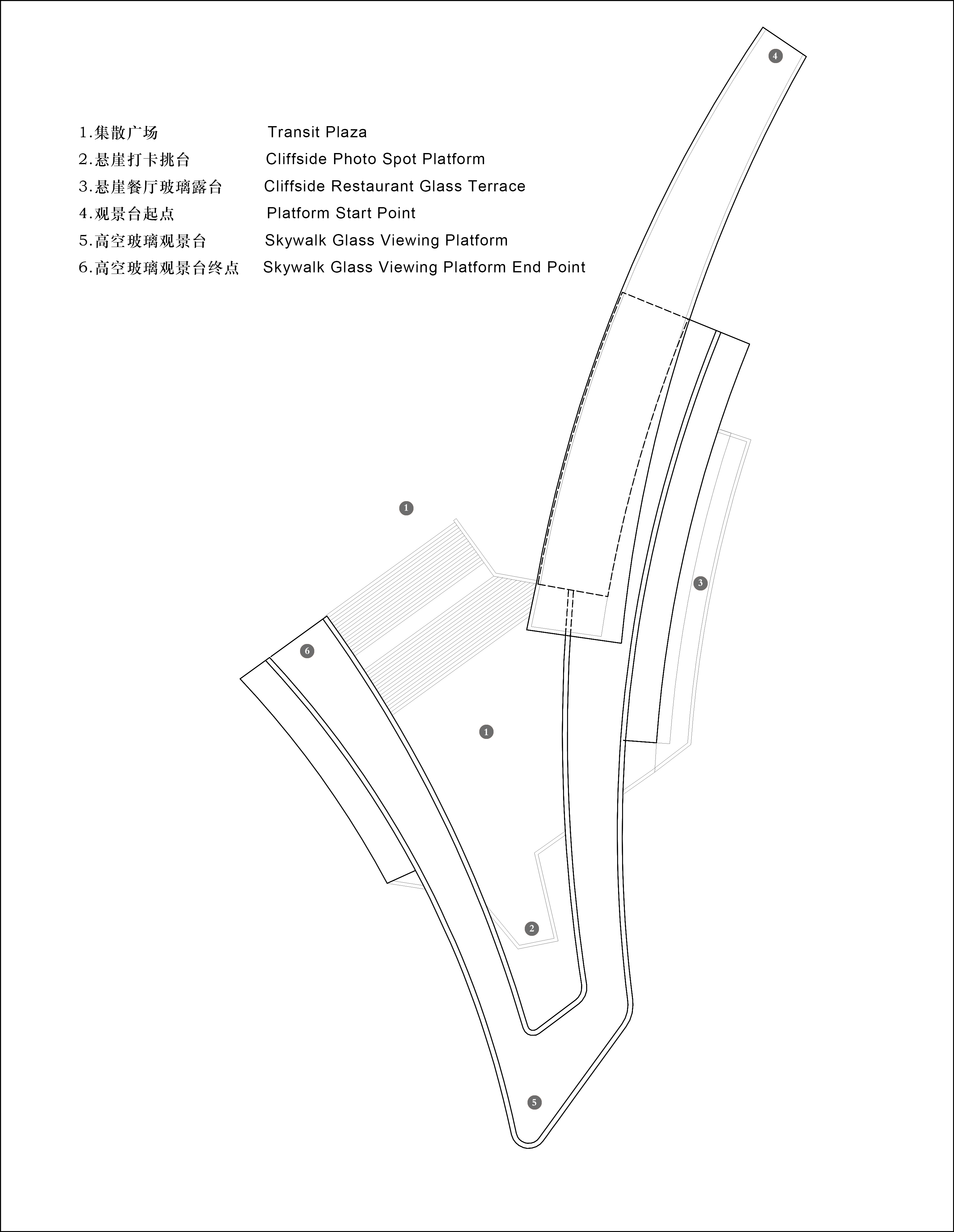




完整项目信息
项目名称: 西藏·怒江72拐大峡谷景区
项目类型:建筑/观景台
项目地点:西藏·昌都市·八宿县
主创团队:小隐建筑事务所(Archermit)
主持建筑师:潘友才
设计总监:杨喆(合伙人)
技术总监:陈仁振(合伙人)
方案设计团队:赵雨、王文双、葛祥鑫、郭津辰、刘欣悦
施工图设计:成都思纳誉联建筑设计有限公司
建筑专业:王玫、王侃、雷鸣、廖善坤、马旭鹏、郝兴其
结构专业:王小波、邓志刚、杜旭、屈芃泽、杨桃
电气专业:莫中开、付钰良
给排水专业:刘根求、伍利
幕墙专业:李刚、宋诗瑶
抗风试验研究:西南交通大学风工程试验研究中心 廖海黎教授团队
钢结构施工过程模拟分析:西南交通大学防护结构研究中心 余志祥教授团队
TMD 阻尼器设计及施工:成都隔震科技有限公司
游乐设施单位:新乡市名扬景区游乐用品有限公司
项目业主:八宿县人民政府、八宿县藏东源创业投资有限公司
运营单位:西藏锕遐部落文化旅游有限责任公司(西藏阿夏文旅)
摄影师:存在建筑-建筑摄影、Chill Shine丘文三映
特别感谢(拍摄):其美次旺、扎西成措、扎西尼玛、白玛拉姆、嘎西、扎西罗布、旦增次旺
撰文:潘友才、葛祥鑫
设计时间:2018年6月—2018年11月
建设时间:2019年3月—2024年9月
用地面积:约100亩
建筑面积:约800平方米
施工单位:西藏来古建筑有限公司
施工人员(按照参与施工的先后顺序排序,共329人):贺军、珠扎、廖恒颖、殷文光、沈雷、周仕能、吴超军、王兴文、胡小林、唐勇、张钟意、陈美、杨明理、康仁强、张晓涛、钟青龙、刘明洪、刘玉、范俊文、洛松次仁、罗中、王继荣、王应东、尹元杰、斯塔次仁、唐永伯、刘有林、西绕塔西、荣旺、丁增、次仁旺堆、周从兴、陈国跃、刘松、周从木、周忠富、肖渊华、郭贞茂、曾华、刘建明、蒋发均、周建、付能刚、贾良志、毛少忠、杨家军、贺学春、尹远贵、曾华、贡秋占堆、杨明启、符小凡、周利祥、周增明、周华松、李长明、周列勇、陈远华、谢聪、杨志陈、尹华松、王应才、向巴、洛松扎西、卓玛群久、胡孝涛、杨雨建、刘凡远、周佑平、曾明元、张军、罗维成、马富双、陈洪刚、达洛群培、次旺扎西、陈思达、马勇、李建华、胡立 、骆开军、刘光洪、余大江、肖华、杨家军、骆泽军、曾明菊、刘小燕、邱康荣、王志彪、代兴华、王逸飞、杨建花、杨兵、代兴建、次仁曲培、洛松泽仁、王永贵、刘红明、黄勇、万正、董光富、唐兴通、董光朝、杨万合、段国万、段定康、刘康彩、徐家菊、段定红、段定飞、邱从荣、邱从安、邱学朗、吕昌达、董贵琼、冉飞、刘帛封、侯光华、张雪彬、张应友、王忠华、冯必华、张波、谢伍各、杨伍伞、安兴祥、安文才、杨木几、杨明启、曹心洲、黄珍品、毛林丽、陈青春、黄本祥、晏家利、郑刚、安天洪、谢司机、刘衍旭、刘凡照、吴天会、庞荀、周军、袁建兵、周家富、周儒华、罗桥友、黎发军、吴秀军、胡正林、骆尚游、吴胜田、周泳宏、陈光能、徐学兵、段荣飞、董光华、周友轩、舒帆、陈阳泉、侯文明、杨通伟、陈思锦、邓宗敏、郑明尧、胡守琪、叶云学、付开德、张国洪、彭再祥、邓巧、陈华顺、李生泽、杨明章、李吉东、王建春、付尚洪、李祥龙、陈学龙、牟国、陈学林、蒋润根、叶瑞贤、陈典然、苟金龙、陈勇、刘光伟、胡朝全、廖治富、蒙晓会、熊友良、彭用凯、杨国勇、周安林、王朝勇、谢光才、谢光武、刘德勋、德西白宗、陈国顺、吴家琼、林元太、洛松达瓦、邦邦珠珠、洛松仁青、洛桑土旦、洛桑央宗、达次、明珠、丁增曲平、四郎洛珠、多吉次仁、巴桑达瓦、顿珠群培、洛珠江村、洛松卓玛、阿旺群培、洛松群培、卓玛拥宗、洛桑那珠、索郎措姆、洛松克珠、丁增曲珍、胡建峰、洛松泽西、布琼、阿旺罗布、阿旺加措、洛松卓嘎、昂旺次列、仓西普次、邓珠仁青、泽曲罗布、罗布旺修、杨天锦、周萍、程巨梁、王希郎、贺明有、余川、扎西尼玛、夏冬、李大海、杨勇、蒋朝礼、邓云华、邓华、邓小波、邓邦文、邓玉松、金星、金崇胜、金崇健、吴洪才、高世茂、黄勇、黄刚、杨芝茹、王朝润、韩美娇、蒋志荣、郑育威、加日、彭小城、张世叁、黄帅帅、林鑫、徐富洪、张兆林、李长文、尚书成、雷朋友、李勇、席达波、杜先兴、郑飞、李达山、李新、刘勤、王德才、郭文、韩德昌、李东升、彭洋、苟承勋、霍东武
建筑材料:钢结构(氟碳漆)、花纹钢板、耐候钢板(藏红色)、镀锌钢矩管、不锈钢型材、SGP夹胶超白玻璃(地面)、夹胶超白玻璃(栏板)、中空超白玻璃(幕墙)、石材、当地毛石、饰面板、涂料(多色)、瓷砖等
版权声明:本文由小隐建筑事务所(Archermit)授权发布。欢迎转发,禁止以有方编辑版本转载。
投稿邮箱:media@archiposition.com
上一篇:相遇在山间:下岩贝景区云峰十二重 / 朱培栋-line+建筑事务所
下一篇:宜昌市档案馆新馆概念设计方案|中南建筑设计院股份有限公司